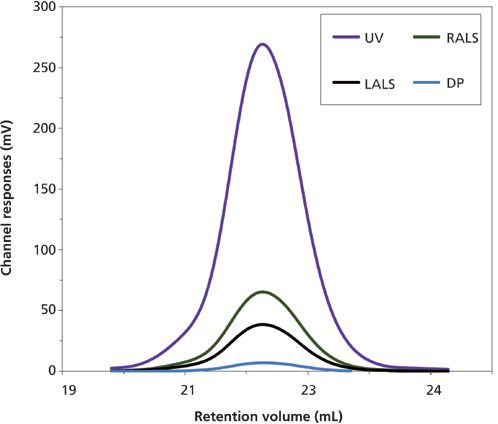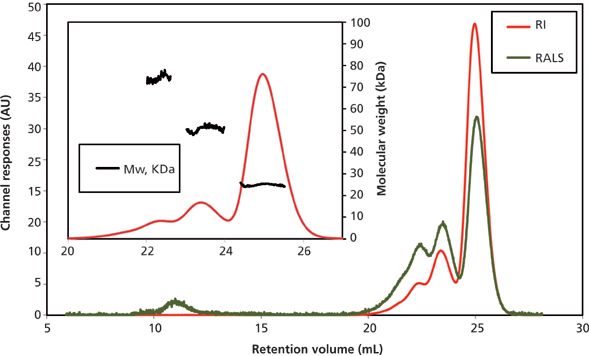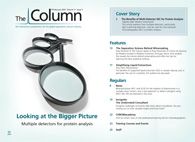The Benefits of Multi-Detector SEC for Protein Analysis
This article explores how multiple detectors, particularly light scattering detectors, may be used for size-exclusion chromatography (SEC) in protein analysis.
Pages 2-7
This article explores how multiple detectors, particularly light scattering detectors, may be used for size-exclusion chromatography (SEC) in protein analysis.
Size-exclusion chromatography (SEC) is widely performed within biopharmaceutical development to determine the molecular weight (Mw) and component concentrations of therapeutic proteins. Molecular weight data can be used to detect and identify aggregates and oligomeric species during purity studies, as well as help to monitor the synthesis of advanced protein compounds. Accurate molecular weight measurement of proteins is therefore essential for the assessment of activity, safety, and clinical efficacy.

Photo Credit: Yagi Studio/Getty Images
Traditional SEC, using a single concentration detector, measures molecular weight relative to a calibration standard rather than "absolute". This is a particular problem for protein analysis, because unlike the standards, many proteins under study are not globular so the measured molecular weight will be inaccurate. In contrast, light scattering detectors enable the measurement of absolute molecular weight without reference to a calibration standard, for all sample types.
This article explores the inclusion of a light scattering detector as part of a multi-detector SEC method to provide robust and reliable measurements of molecular weight, and additional insight into protein behaviour. New research is presented that illustrates how light scattering detection can be used to eliminate inaccuracies that can arise in conventional SEC because of sample-column interactions and irregular sample structures and conformations.
The Importance of Molecular Weight
Many important aspects of a protein's pharmacokinetics, such as bioavailability or clinical efficacy, depend directly upon molecular weight and molecular weight distribution. Precise measurement of molecular weight is, therefore, essential to ensure biotherapeutic formulations consistently meet in vivo performance targets. In some cases, such as in the formation of active oligomer species, an increase in molecular weight is an indication of successful protein manipulation. Carefully tracking oligomer molecular weight can therefore indicate which protein state or assembly is most effective. However, unintentional formation of protein aggregates is a major concern for the biopharmaceutical industry and it is here where SEC is, arguably, most usefully applied.
The detection of unexpected aggregates during quality control is essential and can determine the safety of the batch for clinical use. Aggregates within a biotherapeutic formulation can lower the concentration of monomer species; reduce clinical efficacy; and, more seriously, can alter drug immunogenicity. They can lead to rapid clearance in vivo (reduced efficacy), or an anaphylactic immune response. Learning how to control aggregation is essential to provide assurance in product safety and to secure regulatory approval for the commercialization of new drug products.
Understanding How SEC Works
Separation by SEC is affected on the basis of hydrodynamic size. A dissolved sample flows through a column packed with a microporous packing material, often an inert silica gel. Larger proteins diffuse into fewer pores within the packing material and are first to elute, while smaller proteins diffuse into more of the pores in the packing material and have a longer elution time.
With conventional single-detector SEC, an external calibration curve (relating hydrodynamic size to molecular weight) is used to determine a relative molecular weight distribution from the concentration and retention time data recorded. SEC is easy-to-use and delivers highly reproducible measurements; however, there are inherent issues with single detector SEC. For example, results generated with SEC will not be reliable if:
- The reference standards used do not have the same hydrodynamic size or molecular weight relationship as the sample.
- Electrostatic interactions between the protein and column artificially extend elution time and compromise the reliability of analysis.
In addition, single detector analysis provides very little information about protein structure or conformation.
The emergence of increasingly complex biotherapeutic targets and the concomitant need for "absolute" molecular weight measurements has stimulated a number of developments in SEC technology, such as the use of multiple detectors for measurement of the size fractionated sample. Modern multi-detector SEC systems incorporate a light scattering detector and viscometer alongside conventional RI or UV concentration analysis to provide absolute Mw measurement without calibration, and a more detailed insight into protein structure. The addition of a light scattering detector enables SEC to provide a direct measurement of absolute Mw.
When a molecule interacts with a beam of light it scatters light with an intensity that is directly related to its molecular weight. Static light scattering (SLS) detectors measure intensity and convert these measurements to Mw data using the Rayleigh equation. Depending on the angle at which the scattered light is measured these detectors are referred to as low-angle, right-angle and multi-angle light scattering (LALS, RALS, and MALS) detectors.
All light scattering detectors provide a measurement of Mw that is unaffected by retention time, without an external standard. Multi-detector SEC systems now also routinely include a viscometer to provide information on intrinsic viscosity (IV). IV is inversely proportional to the molecular density of a material. Changes in protein structure, shape, and hydration that lead to a change in the mass to volume relationship of the molecule will therefore cause a change in IV.
Combining IV and absolute Mw together allows researchers to see how this relationship and, consequently, structure, varies as a function of molecular weight distribution. This information can be used to distinguish between oligomeric states, determine the extent of aggregation, and observe hydration or shape parameters.
The following case studies illustrate the application and value of multi-detector SEC both to improve the reliability of routine molecular weight calculations and to deliver valuable insight into protein structure.
Case Study 1: Overcoming the Effects of Sample-Matrix Interactions
In this first study1 SEC was used in the analysis of anthrolysin (ALO), a pore-forming cholesterol-dependent cytolysin secreted by Bacillus anthracis. Research suggests that the complex ALO protein plays a role in the pathogenesis of anthrax, making it an important protein target in the study of the disease.1 Like many proteins, ALO experiences a degree of electrostatic interaction with a number of column packing materials that can artificially extend retention times and impact the reliability of conventional or relative molecular weight measurements.
Experimental: Experiments were performed using a multi-detector SEC system with a light scattering (LALS/RALS) detector, viscometer, and RI detector (Viscotek TDAmax, Malvern Instruments). The experiment was performed using a Superdex 200 sample (GE Healthcare) in a buffer containing 20 mM Tris, 150 mM NaCl; pH 7.3.
Results: Figure 1 shows the chromatogram for the ALO monomer. A retention volume of 22.2 mL was recorded. This would correspond to a molecular weight of 15–20 kDa using traditional calibration methods with the most relevant standard. However, the light scattering data reveals that the weight-average molecular weight (Mw) of the ALO is actually around 53.6 kDa. Without light scattering, this substantial underestimation of Mw is not easily detectable.

Figure 1: Chromatograms of anthrolysin (ALO) from a multi-detector SEC system showing traces from the UV (purple), RALS (green), and LALS (black) detectors; and the viscometer. Using these together enables accurate molecular weight determination and provides insight into protein structure. DP (blue) = differential pressure.
The simultaneous measurements of IV give some insight into the structure of the ALO monomer. Previous research suggests that information about molecular density can be used to make an estimation of the shape and hydration of ALO.1 The results gathered here, a Mw of 53.6 kDa and an IV of 5.1 mL/h, suggest that the extent of hydration of the ALO is low, that the protein is folded, and that the ALO monomer shape is elongated. This conclusion is corroborated by the conical shape observed in X-ray analysis of the structure of the protein (data not shown). Such insight is helpful in formulating proteins to achieve desirable activity in the finished product.
Case Study 2: Overcoming the Effect of Sample Structure on Sample Elution Volume
Many Bcl-2 proteins are molecular transducers, sensitive to internal and external apoptic signals, which play a key role in the regulation of apoptosis (cell death). The aggregation of these proteins leads to the formation of amyloid fibres, which are associated with the onset of numerous neurological degenerative conditions such as Alzheimer's and Parkinson's disease.
Tracking the progression of aggregation is difficult with single detector SEC as hydrodynamic radius and volume often vary unpredictably as mass increases. The longer aggregation is allowed to proceed, the greater the potential difference in structure between the analyte and reference standard.
In this study2 experiments were performed to investigate the in vitro formation of Bcl-2 aggregates following incubation of the protein at 37 °C using a light scattering detector to eliminate the inaccuracies associated with conventional SEC.
Experimental: Analysis of Superose 6HR (GE Healthcare) samples in a buffer of 20 mM sodium phosphate (pH 8) and 150 mM sodium chloride was performed using a Viscotek TDAmax (Malvern Instruments). The aggregation process was assessed following incubation for one day and one week.
Results: Three main species were detected after incubation for one day, at retention volumes 22.6 mL, 23.6 mL, and 25.1 mL. Characterization with light scattering reveals that these peaks correspond to molecular weights of 74 kDa, 51 kDa, and 25 kDa, respectively (Figure 2). The main population of the sample was found to be the later species, which corresponds with the protein's monomeric state.

Figure 2: Chromatogram of Bcl-2 sample shows the presence of three different species after incubation at 37 °C for one day.
Using traditional column calibration, the retention time for the Bcl-2 monomer corresponds with an apparent Mw of 40 kDa. This suggests that the hydrodynamic radius of the monomeric Bcl-2 is larger than expected. Assuming limited interaction between the sample and column matrix, this effect could be attributable to high protein hydration or deviation from a spherical shape. In fact, Bcl-2 is a globular protein with eight alpha helices and a flexible loop linking the first alpha helix to the core of the protein. This flexible loop plays a crucial role in determining the elution profile of the sample, because it effectively gives the protein a larger hydrodynamic radius than would be expected for a compact protein with the same Mw.
Following incubation for a week aggregation was found to be more advanced (results not shown). The results suggest the first step of the fibre growth is the formation of small aggregates, mostly dimers and trimers, which further assembled into larger aggregates. Multi-detector SEC clearly and reliably identifies these growing aggregates, to provide useful insight into the behaviour of the protein.
Summary
The work presented here illustrates the advantages of multi-detector SEC for protein analyses. The use of multiple detectors and, particularly, a light scattering detector, optimizes the informational productivity of SEC experiments. Using a light scattering detector, in combination with a viscometer, makes it possible to detect and monitor changes in molecular weight and structure in a way that is not feasible with a single detector system. The resulting data improves the reliability of aggregate detection studies and expands the application of the technique in advanced biopharmaceutical research.
References
1. R.W. Bourdeau, E. Malito, A. Chenal, B.L. Bishop, M.W. Musch, M.L. Villereal, E.B. Chang, E.M. Mosser, R.F. Rest, and W.J. Tang, J. Biol. Chem. 284, 14645–14656 (2009).
2. A. Chenal, C. Vendrely, H. Vitrac, J.C. Karst, A. Gonneaud, C.E. Blanchet, S. Pichard, E. Garcia, B. Salin, P. Catty, D. Gillet, N. Hussy, C. Marquette, C. Almunia, and V. Forge, J. Mol. Biol. 415, 584–599 (2012).
Stephen Ball is Product Marketing Manager, Nanoparticle and Molecular Characterization, at Malvern Instruments. He holds a degree in Computer Aided Chemistry from the University of Surrey, UK, which included a year in industry working as a research chemist for the Dow Chemical Company in Horgen, Switzerland.
E-mail: stephen.ball@malvern.com
Website: www.malvern.com
This article is from The Column. The full issue can be found here>>

Common Challenges in Nitrosamine Analysis: An LCGC International Peer Exchange
April 15th 2025A recent roundtable discussion featuring Aloka Srinivasan of Raaha, Mayank Bhanti of the United States Pharmacopeia (USP), and Amber Burch of Purisys discussed the challenges surrounding nitrosamine analysis in pharmaceuticals.
Regulatory Deadlines and Supply Chain Challenges Take Center Stage in Nitrosamine Discussion
April 10th 2025During an LCGC International peer exchange, Aloka Srinivasan, Mayank Bhanti, and Amber Burch discussed the regulatory deadlines and supply chain challenges that come with nitrosamine analysis.
Polysorbate Quantification and Degradation Analysis via LC and Charged Aerosol Detection
April 9th 2025Scientists from ThermoFisher Scientific published a review article in the Journal of Chromatography A that provided an overview of HPLC analysis using charged aerosol detection can help with polysorbate quantification.











